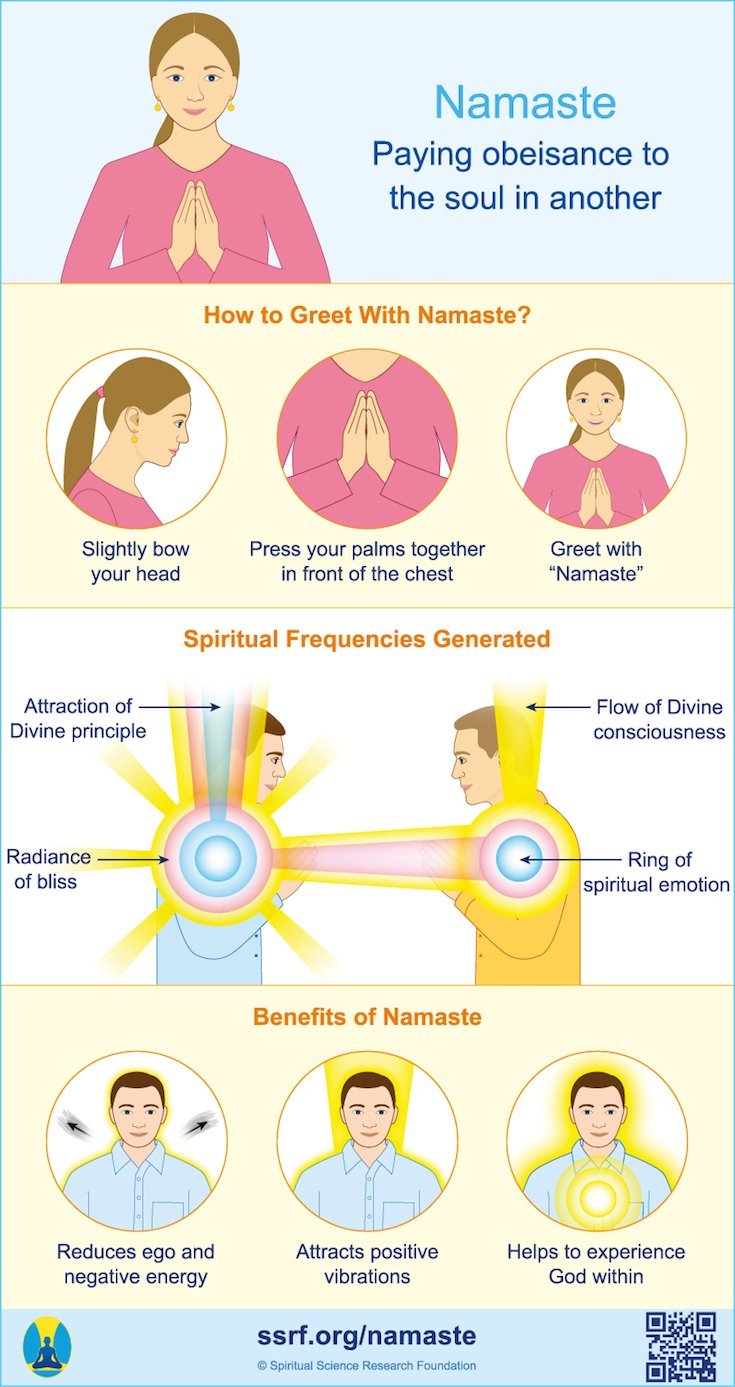The True Meaning Of Namaste
A yogi sitting cross-legged in front of their class, hands pressed together into a prayer position, waiting to begin. They take a deep breath, bow deeply and ‘Namaste’. It feels spiritual, sacred and almost reverent. Their students mirror the pose and bow to their teacher, returning the ‘Namaste’ in unison. It’s such a deeply ingrained part of the yoga practice that it doesn’t seem like yoga without it.
Namaste is a well-known phrase that you are likely to hear at the end of every yoga class. But what exactly does it mean? Where did it come from? Why is it so widely used as a greeting and a goodbye in the meditation and yoga communities? Is Namaste being used correctly, as intended?
What Does Namaste Mean?
If we take a literal view on the word, then the translation from Sanskrit breaks down into ‘Nama’, which means ‘bow’, and ‘te’, which means ‘you’. So Namaste means ‘I bow to you’.
However, if you ask anyone who practices yoga what the word means, they will probably reply with ‘the Divine in me honours the Divine in you’, or some variation on that. This is a common interpretation, and it originally comes from the Hindu belief that God resides in everyone, and so any person you greet deserves the same respect you would give to God. It’s an acknowledgement of the soul in you of the soul in another.
In both yoga practices South Asian cultures, Namaste is used as a greeting. But it’s more formal than a ‘hey there’ or even a simple ‘hello’. It’s a sign of respect and reverence that goes across the generations. In India, you will also find the praying hands position (known as Anjali Mudra) is a part of the greeting, just as important as the word itself.
So when a yoga teacher and their class exchange Namaste at the beginning of a class, it’s a sign of respect and honour for both student and teacher, and symbolic of the spiritual connection the practice can bring.
How To Pronounce Namaste
There’s always a bit of a disagreement on how to actually pronounce Namaste, but we will always refer to the South Asian cultures for the correct pronunciation. Typically English and American speakers will use a much shorter ‘a’ sound to the vowels, as well as putting too much emphasis on the final syllable of the word, so it ends up sounding like: nah-mah-STAY. But if you want to pronounce it correctly, then you need to shift the emphasis to the middle syllable and replace those ‘a’ sounds with a ‘u’. The result should sound lie: nuh-MUH-stheh.
The reason it’s so common to pronounce it the first way is simple – the sounds of the language aren’t as familiar to native English speakers. Particularly that final syllable, which is very familiar to speakers from South Asia, can feel a strange on the English tongue, so it can be difficult to get the hang of. Instead of the hard ‘st’ sound we are used to, it’s a softer ‘th’ sound, with. Try touching your tongue to the back of your front teeth as you say it and you’ll be a lot closer to correct. The other reason we tend to pronounce it incorrectly is that we’ve only ever heard it that way – TV and Film often depict the western pronunciation, so unless you seek it out or visited South Asia you likely wouldn’t ever hear it.
Source: https://www.spiritualresearchfoundation.org/
Other Meanings Of Namaste
We’ve already explained the literal and Hindu translations for Namaste, but it is a word with a slightly flexible meaning. So there have been many translations of the word, all of which centre around the same idea, but are all beautiful in their own way. These are some of our favourites:
I honour the place in you where the entire universe dwells
I bow to the place in you that is love, light and joy
When you and I bow to our true nature, we are one
My soul recognises your soul
We are the same, we are one
I honour the place in you that is the same as it is in me
All of these transitions bring the same image to mind – I honour and respect myself, and you. That is the true essence of Namaste.
Is It Ok Not To Say Namaste?
Of course, you may not feel comfortable using Namaste right away. While Namaste is a popular expression in the yoga community and something many yogis use frequently, it isn’t something that you have to do. Especially if it makes you feel uncomfortable. Just like your body might not feel ready to transition into a challenging yoga pose, your mind and spirit may not be ready to say Namaste. That’s OK! You can say other things, like ‘thank you’, ‘I appreciate you’, and ‘I respect you’ – which are all basically saying the same thing. It’s a spiritual word, and you should only ever use it when you feel ready and comfortable to do so.
If you’d like to expand your understanding of yoga practice, lifestyle and theory, there’s no better place to start than a yoga retreat. Our yoga retreats are suitable for students and yogis of any experience level, and help you immerse yourself in the practice and ideology of yoga without all the distractions of modern life. If you would like to find out more, just click here to view our upcoming retreats, or get in touch with the team today.


